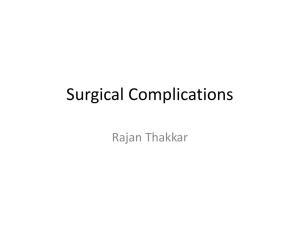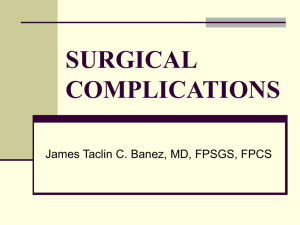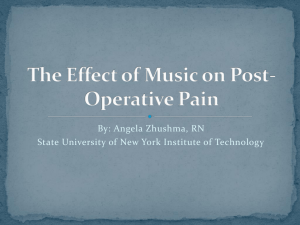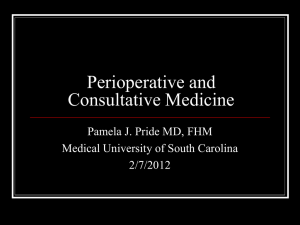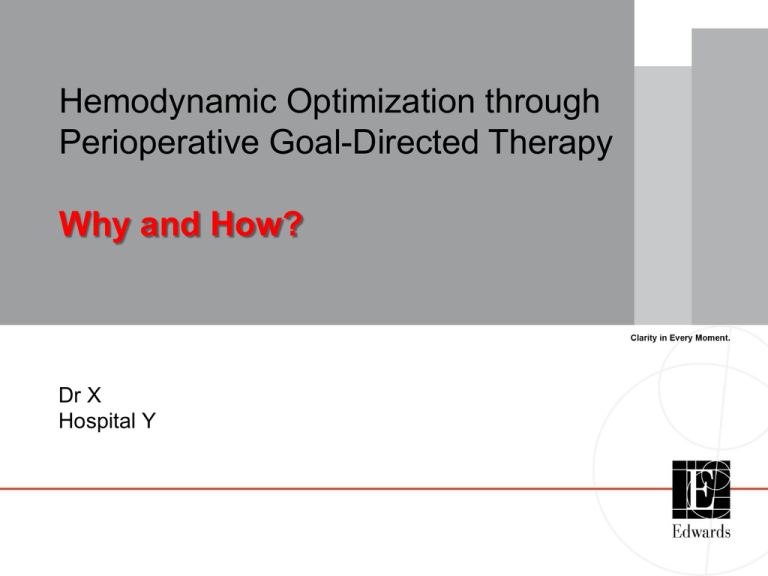
Hemodynamic Optimization through
Perioperative Goal-Directed Therapy
Why and How?
Dr X
Hospital Y
Disclosures
• Paid consultant for Edwards Lifesciences
• Affiliation
• Other (as appropriate)
2
WHY?
3
Hemodynamic Optimization: Why?
• Complications are not exceptions
4
Most Common Post-Surgical Complications
Infection
— Pneumonia
— Urinary tract infection
— Superficial wound infection
— Deep wound infection
— Organ-space wound infection
— Systemic sepsis or septic shock
Gastro-intestinal
— Nausea and vomiting
— Ileus (paralytic or functional)
— Acute bowel obstruction
— Anastomotic leak
— Gastro-intestinal hypertension
— Hepatic dysfunction
— Pancreatitis
Respiratory
— Prolonged mechanical ventilation (>48h)
— Unplanned intubation or reintubation
— Respiratory failure or ARDS
— Pleural effusion
Renal
— Renal insufficiency (increase in creatinine levels
or decrease in urine output)
— Renal failure (requiring dialysis)
http://www.patient.co.uk/doctor/common-postoperative-complications
Cardiovascular
— Deep venous thrombosis
— Pulmonary embolism
— Myocardial infraction
— Hypotension
— Arrhythmia
— Cardiogenic pulmonary edema
— Cardiogenic shock
— Infarction of GI track
— Distal ischemia
— Cardiac arrest (exclusive of death)
Neuro
— Stroke or cerebro-vascular accident
— Coma
— Altered mental status or cognitive dysfunction or
delirium
Hemato
— Bleeding requiring transfusion
— Anemia
— Coagulopathy
Other
— Vascular graft of flap failure
— Wound dehiscence
— Peripheral nerve injury
— Pneumothorax
5
Variation in Hospital Mortality Associated with
Inpatient Surgery.
Amir A. Ghaferi, M.D., John D. Birkmeyer, M.D.,
and Justin B. Dimick, M.D., M.P.H.
N Engl J Med 2009
• 84,730 inpatients
• General or vascular surgery
• NSQIP database (designed to record
post-surgical complications until day 30)
6
NSQIP Complications
M = Major
m = minor
Infection
Cardiovascular
M— Pneumonia
m— Urinary tract infection
m— Superficial wound infection
M— Deep wound infection
M— Organ-space wound infection
M— Systemic sepsis or septic shock
m— Deep venous thrombosis
M— Pulmonary embolism
M— Myocardial infraction
— Hypotension
— Arrhythmia
— Cardiogenic pulmonary edema
— Cardiogenic shock
— Infarction of GI track
— Distal ischemia
— Cardiac arrest (exclusive of death)
Gastro-intestinal
— Nausea and vomiting
— Ileus (paralytic or functional)
— Acute bowel obstruction
— Anastomotic leak
— Gastro-intestinal hypertension
— Hepatic dysfunction
— Pancreatitis
Respiratory
Neuro
M— Stroke or cerebro-vascular accident
— Coma
— Altered mental status or cognitive dysfunction or
delirium
M— Prolonged mechanical ventilation (>48h)
M— Unplanned intubation or reintubation
— Respiratory failure or ARDS
— Pleural effusion
Hemato
Renal
Other
m — Renal insufficiency (increase in creatinine levels
or decrease in urine output)
M— Renal failure (requiring dialysis)
M— Vascular graft of flap failure
M— Wound dehiscence
— Peripheral nerve injury
— Pneumothorax
http://www.patient.co.uk/doctor/common-postoperative-complications
M— Bleeding requiring transfusion
— Anemia
— Coagulopathy
7
Variation in Hospital Mortality Associated with
Inpatient Surgery.
Amir A. Ghaferi, M.D., John D. Birkmeyer, M.D.,
and Justin B. Dimick, M.D., M.P.H.
N Engl J Med 2009
• Complication rate was 24.6-26.9%
• Major complication rate was 16.2-18.2%
8
Prioritizing Quality Improvement
in General Surgery.
Schilling et al.
J Am Coll Surg. 2008; 207:698–704.
129,233 cases
Complication rates depend on the surgical procedure
Surgery
Morbidity rate %
Esophagectomy
55.1
Pelvic exenteration
45.0
Pancreatectomy
34.9
Colectomy
28.9
Gastrectomy
28.7
Liver resection
27
Successful Implementation of the
Department of Veterans Affairs’ NSQIP in the Private
Sector: The Patient Safety in Surgery Study.
Khuri et al.
Ann Surg 2008
129,546 cases
Complication rates depend on the patient
Risk factor
Odd ratio
ASA 4/5 vs 1/2
1.9
ASA 3 vs 1/2
1.5
Dyspnea at rest vs. none
1.4
History of COPD
1.3
Dyspnea with minimal exertion
vs. none
1.2
Hemodynamic Optimization: Why?
• Complications are not exceptions
• Complications are costly
Synergistic Implications of Multiple Postoperative Outcomes. Melissa M. Boltz, DO, Christopher S. Hollenbeak, Ph.D., Gail Ortenzi, RN, BSN, and Peter W.
Dillon, M.D. Am J Med Quality 2012
11
Synergistic Implications of Multiple
Postoperative Outcomes.
Melissa M. Boltz, DO, Christopher S. Hollenbeak, Ph.D.,
Gail Ortenzi, RN, BSN, and Peter W. Dillon, M.D.
Am J Med Quality 2012
2250 Patients Undergoing General and Vascular Surgery
$42790
Extra cost $
$12802
$6358
Complications Have a Cost
All Complications
(6 Studies)
Acute Kidney Injury
(4 Studies)
Surgical Site Infections
(7 Studies)
Hosp Assoc Pneumonia
(8 Studies)
Urinary Tract Infection
(5 Studies)
Major GI Complications
(4 Studies)
Minor GI Complications
(3 Studies)
$4,278
$42,790
$2,590
$22,023
$2,425
$27,969
$3,237
$767
$64,544
$12,828
$6,214
$77,483
$5,412 $8,296
Synergistic Implications of Multiple Postoperative Outcomes. Melissa M. Boltz, DO, Christopher S. Hollenbeak, Ph.D., Gail Ortenzi, RN, BSN, and Peter W.
Dillon, M.D. Am J Med Quality 2012
13
Complications Have a Cost
All Complications
(6 Studies)
Acute Kidney Injury
(4 Studies)
Surgical Site Infections
(7 Studies)
Hosp Assoc Pneumonia
(8 Studies)
Urinary Tract Infection
(5 Studies)
Major GI Complications
(4 Studies)
Minor GI Complications
(3 Studies)
$4,278
$42,790
$2,590
$22,023
$2,425
$27,969
$3,237
$767
$64,544
$12,828
$6,214
$77,483
$5,412 $8,296
Synergistic Implications of Multiple Postoperative Outcomes. Melissa M. Boltz, DO, Christopher S. Hollenbeak, Ph.D., Gail Ortenzi, RN, BSN, and Peter W.
Dillon, M.D. Am J Med Quality 2012
14
Complications Have a Cost
All Complications
(6 Studies)
Acute Kidney Injury
(4 Studies)
Surgical Site Infections
(7 Studies)
Hosp Assoc Pneumonia
(8 Studies)
Urinary Tract Infection
(5 Studies)
Major GI Complications
(4 Studies)
Minor GI Complications
(3 Studies)
$4,278
$42,790
$2,590
$22,023
$2,425
$27,969
$3,237
$767
$64,544
$12,828
$6,214
$77,483
$5,412 $8,296
Synergistic Implications of Multiple Postoperative Outcomes. Melissa M. Boltz, DO, Christopher S. Hollenbeak, Ph.D., Gail Ortenzi, RN, BSN, and Peter W.
Dillon, M.D. Am J Med Quality 2012
15
More Reliable Approach
Synergistic Implications of Multiple Postoperative Outcomes. Melissa M. Boltz, DO, Christopher S. Hollenbeak, Ph.D., Gail Ortenzi, RN, BSN, and Peter W.
Dillon, M.D. Am J Med Quality 2012
16
Synergistic Implications of Multiple
Postoperative Outcomes.
Melissa M. Boltz, DO, Christopher S. Hollenbeak, Ph.D.,
Gail Ortenzi, RN, BSN, and Peter W. Dillon, M.D.
Am J Med Quality 2012
2250 Patients Undergoing General and Vascular Surgery
+ $18,000
Synergistic Implications of Multiple Postoperative Outcomes. Melissa M. Boltz, DO, Christopher S. Hollenbeak, Ph.D., Gail Ortenzi, RN, BSN, and Peter W.
Dillon, M.D. Am J Med Quality 2012
17
Hemodynamic Optimization: Why?
• Complications are not exceptions
• Complications are costly
• Complications are responsible for
prolonged LOS and readmissions
Synergistic Implications of Multiple Postoperative Outcomes. Melissa M. Boltz, DO, Christopher S. Hollenbeak, Ph.D., Gail Ortenzi, RN, BSN, and Peter W.
Dillon, M.D. Am J Med Quality 2012
18
Synergistic Implications of Multiple
Postoperative Outcomes.
Melissa M. Boltz, DO, Christopher S. Hollenbeak, Ph.D.,
Gail Ortenzi, RN, BSN, and Peter W. Dillon, M.D.
Marginal Length of Stay
Am J Med Quality 2012
Number of Postoperative Events
19
Prioritizing Quality Improvement
in General Surgery.
Schilling et al.
J Am Coll Surg. 2008; 207:698–704.
12,767 colectomies
Average excess LOS for adverse events = 9.8 days
Association Between Occurrence of a Postoperative
Complication and Readmission.
Implications for Quality Improvement and Cost Savings
Elise H. Lawson, M.D. MSHS, Bruce Lee Hall, M.D. Ph.D, MBA, Rachel Louie, MS,
Susan L. Ettner, Ph.D., David S. Zingmond, M.D., Ph.D, Lein Han, Ph.D,
Michael Rapp, M.D., JD and Clifford Y. Ko, M.D. MS, MSHS
Ann Surg 2013
21
Hemodynamic Optimization: Why?
• Complications are not exceptions
• Complications are costly
• Complications are responsible for
prolonged LOS and readmissions
• Complications affect long-term survival
Determinants of Long-Term Survival After Major Surgery and the Adverse Effect of Postoperative Complications. Shukri F. Khuri, M.D., William G.
Henderson, Ph.D., Ralph G. DePalma, M.D., Cecilia Mosca, MSPH, Nancy A. Healey, BS, Dharam J. Kumbhani, M.D., SM and the Participants in the VA
National Surgical Quality Improvement Program Ann Surg 2005
22
Determinants of Long-Term Survival After
Major Surgery and the Adverse Effect
of Postoperative Complications.
Shukri F. Khuri, M.D., William G. Henderson, Ph.D., Ralph G. DePalma, M.D.,
Cecilia Mosca, MSPH, Nancy A. Healey, BS, Dharam J. Kumbhani, M.D., SM
and the Participants in the VA National Surgical Quality Improvement Program
Ann Surg 2005
• 105,951 surgical patients (GI, vasc, hip)
• 8 year follow-up
23
Determinants of Long-Term Survival After
Major Surgery and the Adverse Effect
of Postoperative Complications.
Shukri F. Khuri, M.D., William G. Henderson, Ph.D., Ralph G. DePalma, M.D.,
Cecilia Mosca, MSPH, Nancy A. Healey, BS, Dharam J. Kumbhani, M.D., SM
and the Participants in the VA National Surgical Quality Improvement Program
Ann Surg 2005
• « The most important determinant of decreased
postoperative survival was the occurrence, within
30 days postop, of any complication »
24
Determinants of Long-Term Survival After
Major Surgery and the Adverse Effect
of Postoperative Complications.
Shukri F. Khuri, M.D., William G. Henderson, Ph.D., Ralph G. DePalma, M.D.,
Cecilia Mosca, MSPH, Nancy A. Healey, BS, Dharam J. Kumbhani, M.D., SM
and the Participants in the VA National Surgical Quality Improvement Program
Ann Surg 2005
• « The most important determinant of decreased
postoperative survival was the occurrence, within
30 days postop, of any complication »
• « Independent of preoperative patient risk, the
occurrence of a 30-day complication reduced
median patient survival by 69% »
25
Hemodynamic Optimization: Why?
• Complications are not exceptions
• Complications are costly
• Complications are responsible for
prolonged LOS and readmissions
• Complications affect long-term survival
• Hemodynamic Optimization through
PGDT is a KEY to prevent post-surgical
complications
Data on file.
26
Hemodynamic Optimization through
PGDT is KEY
• Patho-physiology
Data on file.
27
Effects of Low Volume Fluid Administration
• Low preload, low cardiac output,
low blood pressure, low perfusion
• Arrhythmia (hypovolemia)
• GI dysfunction (hypoperfusion)
• Postoperative ileus, PONV
• Upper GI bleeding
• Anastomotic leak
• Infectious complication
(tissue hypoperfusion)
• Acute renal insufficiency or failure
(decreased renal blood flow)2002; 89: 622-632.
Data on file.
28
Effects of High Volume Fluid Administration
• Pulmonary edema, prolonged
mechanical ventilation
• GI dysfunction
• Abdominal compartment syndrome
• Ileus
• Anastomotic leak
• Hemodilution and coagulopathy002; 89: 622-632.
Data on file.
29
Where Do We Want to Be?
Wet, Dry or Something Else?
British Journal of Anaesthesia 97 (6): 755-7 (2006)
Doi:10.1093/bja/ae1290
Editorial by M. C. Bellamy
Curve A represents the hypothesized line of risk.
Broken line B represents a division between patient
groups in a ‘wet vs dry’ study. Broken line C represents a
division between patient and groups in an ‘optimized vs
non-optimized’ study
30
Where Do We Want to Be?
Wet, Dry or Something Else?
British Journal of Anaesthesia 97 (6): 755-7 (2006)
Doi:10.1093/bja/ae1290
TARGET ZONE
Curve A represents the hypothesized line of risk.
Broken line B represents a division between patient
groups in a ‘wet vs dry’ study. Broken line C represents a
division between patient and groups in an ‘optimized vs
non-optimized’ study
31
Where Do We Want to Be?
Wet, Dry or Something Else?
British Journal of Anaesthesia 97 (6): 755-7 (2006)
Doi:10.1093/bja/ae1290
TARGET ZONE
Curve A represents the hypothesized line of risk.
Broken line B represents a division between patient
groups in a ‘wet vs dry’ study. Broken line C represents a
division between patient and groups in an ‘optimized vs
non-optimized’ study
32
Where Do We Want to Be?
Wet, Dry or Something Else?
British Journal of Anaesthesia 97 (6): 755-7 (2006)
Doi:10.1093/bja/ae1290
TARGET ZONE
Curve A represents the hypothesized line of risk.
Broken line B represents a division between patient
groups in a ‘wet vs dry’ study. Broken line C represents a
division between patient and groups in an ‘optimized vs
non-optimized’ study
33
A Low CVP Does Not Mean Your
Patient Needs Fluid
REVIEW ARTICLES
Does the Central Venous Pressure Predict Fluid
Responsiveness? An Updated Meta-Analysis
and a Plea for Some Common Sense.
Paul E. Marik, M.D., FCCM, Rodrigo Cavallazzi, M.D.
Crit Care Med 2013; 41:1774-1781
34
A Low CVP Does Not Mean Your
Patient Needs Fluid
REVIEW ARTICLES
Does the Central Venous Pressure Predict Fluid
Responsiveness? An Updated Meta-Analysis
and a Plea for Some Common Sense.
Paul E. Marik, M.D., FCCM, Rodrigo Cavallazzi, M.D.
Crit Care Med 2013; 41:1774-1781
CONCLUSION: There are no data to support the
widespread practice of using central venous pressure
to guide the fluid therapy. This approach to fluid
resuscitation should be abandoned.
35
Where Do We Want to Be?
Wet, Dry or Something Else?
British Journal of Anaesthesia 97 (6): 755-7 (2006)
Doi:10.1093/bja/ae1290
TARGET ZONE
Curve A represents the hypothesized line of risk.
Broken line B represents a division between patient
groups in a ‘wet vs dry’ study. Broken line C represents a
division between patient and groups in an ‘optimized vs
non-optimized’ study
36
Changes in Blood Pressure do not
Reflect Changes in Blood Flow
PERIOPERATIVE MEDICINE
Can Changes in Arterial Pressure be Used to Detect
Changes in Cardiac Output During Volume
Expansion in the Perioperative Period?
Yannick Le Manach, M.D., Ph.D., Christoph K. Hofer, M.D., Ph.D.
Jean-Jacques Lehot, M.D., Ph.D., Benoit Vallet, M.D., Ph.D., Jean-Pierre Goarin, M.D.
Benoit Tavernier, M.D., Ph.D., Maxime Cannesson, M.D., Ph.D.
Anesthesiology 2013
37
Changes in Blood Pressure do not
Reflect Changes in Blood Flow
PERIOPERATIVE MEDICINE
PERIOPERATIVE MEDICINE
Can Changes in Arterial Pressure be Used to Detect
Changes in Cardiac Output During Volume
Expansion in the Perioperative Period?
Yannick Le Manach, M.D., Ph.D., Christoph K. Hofer, M.D., Ph.D.
Jean-Jacques Lehot, M.D., Ph.D., Benoit Vallet, M.D., Ph.D., Jean-Pierre Goarin, M.D.
Benoit Tavernier, M.D., Ph.D., Maxime Cannesson, M.D., Ph.D.
Anesthesiology 2013
NO!
38
Where Do We Want to Be?
Wet, Dry or Something Else?
British Journal of Anaesthesia 97 (6): 755-7 (2006)
Doi:10.1093/bja/ae1290
TARGET ZONE
Curve A represents the hypothesized line of risk.
Broken line B represents a division between patient
groups in a ‘wet vs dry’ study. Broken line C represents a
division between patient and groups in an ‘optimized vs
non-optimized’ study
39
Frank-Starling relationship between
preload and stroke volume
Stroke Volume
Preload
Wet, Dry or Something Else? British Journal of Anaesthesia 97 (6): 755-7 (2006) Doi:10.1093/bja/ae1290
Frank-Starling relationship between
preload and stroke volume
Stroke Volume
TARGET ZONE
Preload
Wet, Dry or Something Else? British Journal of Anaesthesia 97 (6): 755-7 (2006) Doi:10.1093/bja/ae1290
Frank-Starling relationship between
preload and stroke volume
Stroke Volume
TARGET ZONE
HYPO
HYPER
Preload
Wet, Dry or Something Else? British Journal of Anaesthesia 97 (6): 755-7 (2006) Doi:10.1093/bja/ae1290
The Stroke Volume Optimization Strategy
Stroke Volume
∆SV < 10%
∆SV > 10%
∆SV >> 10%
∆P = fluid-induced increase in preload
HYPO
HYPER
Preload
Wet, Dry or Something Else? British Journal of Anaesthesia 97 (6): 755-7 (2006) Doi:10.1093/bja/ae1290
The Stroke Volume Optimization Strategy
Stroke Volume
SVV < 10%
SVV > 10%
SVV >> 10%
Preload
Wet, Dry or Something Else? British Journal of Anaesthesia 97 (6): 755-7 (2006) Doi:10.1093/bja/ae1290
The Stroke Volume Optimization Strategy
Stroke Volume
SVV < 10%
SVV > 10%
SVV >> 10%
HYPER
HYPO
Preload
Wet, Dry or Something Else? British Journal of Anaesthesia 97 (6): 755-7 (2006) Doi:10.1093/bja/ae1290
Where Do We Want to Be?
Wet, Dry or Something Else?
British Journal of Anaesthesia 97 (6): 755-7 (2006)
Doi:10.1093/bja/ae1290
TARGET ZONE
Curve A represents the hypothesized line of risk.
Broken line B represents a division between patient
groups in a ‘wet vs dry’ study. Broken line C represents a
division between patient and groups in an ‘optimized vs
non-optimized’ study
46
Where Do We Want to Be?
Wet, Dry or Something Else?
British Journal of Anaesthesia 97 (6): 755-7 (2006)
Doi:10.1093/bja/ae1290
TARGET ZONE
Curve A represents the hypothesized line of risk.
Broken line B represents a division between patient
groups in a ‘wet vs dry’ study. Broken line C represents a
division between patient and groups in an ‘optimized vs
non-optimized’ study
47
Where Do We Want to Be?
Wet, Dry or Something Else?
British Journal of Anaesthesia 97 (6): 755-7 (2006)
Doi:10.1093/bja/ae1290
TARGET ZONE
Curve A represents the hypothesized line of risk.
Broken line B represents a division between patient
groups in a ‘wet vs dry’ study. Broken line C represents a
division between patient and groups in an ‘optimized vs
non-optimized’ study
48
Monitoring Flow Parameters is Easy
with Pulse Contour Methods
•
•
•
•
Plug and play techniques
Non-operator dependent
Stroke Volume (SV) and Cardiac output (CO)
Stroke Volume Variation (SVV) = reliable
predictor of fluid responsiveness
• Option for patients with an A-line =
Arterial Pressure –based Cardiac Output
• Option for patients without an A-line =
Arterial Pulse Contour Analysis
49
Hemodynamic Optimization through
PGDT is KEY
• Patho-physiology
• Outcome studies
50
Evidence-Based Medicine: Using a
Hemodynamic Protocol with Specific Goals
(Perioperative Goal-Directed Therapy)
Based on Flow Measurements is Useful
N.I.C.E. (NHS) Protocol - National institute for health and clinical excellence / national health system (NHS) Perioperative Goal-Directed Therapy protocol
Superiority of Hemodynamic Optimization Over
Standard Fluid Management
• > 30 positive RCTs
• Several meta-analyses
• Several QIPs
52
Clinical Benefits of Hemodynamic Optimization
Over Standard Fluid Management
Reduction in
Average odd or risk ratio
(confidence interval)
Author
(reference)
Acute kidney injury
0.64 (0.50-0.83)
0.71 (0.57-0.90)
0.67 (0.46-0.98)
Brienza (9)
Grocott (13)
Corcoran (14)
Minor GI complications
0.29 (0.17-0.50)
Giglio (10)
Minor GI complications
0.42 (0.27-0.65)
Giglio (10)
Surgical site infection
0.58 (0.46-0.74)
0.65 (0.50-0.84)
Dalfino (11)
Grocott (13)
Urinary tract infection
0.44 (0.22-0.88)
Dalfino (11)
Pneumonia
0.71 (0.55-0.92)
0.74 (0.57-0.96)
Dalfino (11)
Corcoran (14)
Respiratory failure
0.51 (0.28-0.93)
Grocott (13)
Total morbidity rate
0.44 (0.35-0.55)
0.68 (0.58-0.80)
Hamilton (12)
Grocott53(13)
Effects of Hemodynamic Optimization
on HLOS
Reduction in
Hospital length of stay
Average odd or risk ratio
(confidence interval)
Author
(reference)
1.16 (0.43-1.89)
1.95 (0.57-0.90)
Grocott (13)
Corcoran (14)
54
Main RCTs Limitations
• Highly selected patients
• Extra-resources
• Hawthorne effect
Hamilton2010; Dalfino2011; Giglio2009; Corcoran2012; Grocott2013; Brienza2009
RCTs Are Not Real Life
RCT
QIP
Before-After Comparison
Comparative
Evaluation
Now
Period 1
Implementation
Treatment protocol
Period 2
Data collection 1
Data collection 2
From an e-database
(mortality, ICU LOS,
HLOS, morbidity)
From an e-database
(mortality, ICU LOS,
HLOS, morbidity)
Perioperative hemodynamic therapy: quality improvement programs should help to resolve our uncertainty Frederic Michard*1, Maxime Cannesson2 and
Benoit Vallet3 Michard et al. Critical Care 2011, 15:445 http://ccforum.com/content/15/5/445
58
Quality Improvement Report
Kuper et al.
BMJ 2011;342:d3016 doi: 10.1136/bmj.d3016
Age
Control (n=658)
Intervention (n=649)
≤60
196 (29.8)
237 (36.5)
61-70
175 (26.6)
167 (25.7)
≥71
287 (43.6)
245 (37.8)
339 (51.5)
355 (54.7)
4 (0.6)
9 (1.4)
139 (21.1)
133 (20.5)
Kidney or pancreas transplant
48 (7.3)
33 (5.1)
Upper gastrointestinal
79 (12.0)
55 (8.5)
Urology
21 (3.2)
45 (6.9)
Vascular
28 (12.6)
19 (2.9)
Mean (SD) POSSUM score
34.3 (8.3)
34.0 (8.5)
ASA physical status grade:
83 (12.6)
108 (16.6)
2
299 (45.4)
313 (48.2)
3
247(37.5)
185 (28.5)
4
26 (4.0)
41 (6.3)
5
1 (0.2)
1 (0.2)
Urgent or emergency
201(30.5)
177 (27.3)
Elective or scheduled
457 (69.5)
472 (72.7)
Surgical specialty:
Colorectal
Gynecological
Orthopaedic
1
Mode of surgery:
Quality Improvement Report Kuper et al. BMJ 2011;342:d3016 doi: 10.1136/bmj.d3016
Hemodynamic Optimization Protocol
N.I.C.E. (NHS) Protocol - National institute for health and clinical excellence / national health system (NHS) Perioperative Goal-Directed Therapy protocol
HLOS Reduction
Control
Intervention
Patient group
No
Mean (SD) stay
No
Mean (SD) stay
P value
Total
658
18.7 (24.4)
649
15.1 (16.7)
0.002
Derby
201
10.9 (10.7)
201
8.4 (7.3)
0.007
Manchester
232
25.5 (34.8)
224
19.8 (23.2)
0.043
Whittington
255
15.7 (13.4)
224
13.4 (12.7)
0.108
Postoperative
658
17.2 (24.0)
649
13.6 (15.9)
0.001
Quality Improvement Report Kuper et al. BMJ 2011;342:d3016 doi: 10.1136/bmj.d3016
UC Irvine QI Program
Permission obtained from Dr. Cannesson to utilize this information.
63
UC Irvine QI Program
Initial Experience
Pre Implementation
(n=128)
Post Implementation
(n=116)
8%
62%
10 ml/kg/h
7 ml/kg/h
Surgery duration
456 min
422 min
Estimated blood loss
550 ml
440 ml
LOS ICU
2.5 days
1.6 days
LOS hospital
12.2 days
9.5 days
45%
35%
4.4 units
2.7 units
Full ERAS package application
Intraoperative fluid administration
Blood transfusion
PRBC per patient transfused
Permission obtained from Dr. Cannesson to utilize this information.
64
UC Irvine QI Program
Permission obtained from Dr. Cannesson to utilize this information.
65
Hemodynamic Optimization through
PGDT is KEY
• Patho-physiology
• Outcome studies
• Recommendations and guidelines
66
2012: Enhanced Recovery Partnership
CONSENSUS STATEMENT
OPEN ACCESS
Perioperative fluid management: Consensus
Statement from the enhanced recovery partnership
Perioperative Medicine 2012
67
Individualized Goal-Directed
Fluid Therapy
The Enhanced Recovery Partnership recommends
the use of intra-operative fluid management
technologies to enhance treatment with the aim of
avoiding both hypovolaemia and fluid excess. This
should be decided on a case-by-case basis adhering
to local guidelines in the context of NICE
recommendations, national guidelines and the
Innovation, Health and Wealth Review.
Perioperative fluid management: Consensus Statement from the enhanced recovery partnership Perioperative Medicine 2012
The Enhanced Recovery Partnership recommends
that all Anaesthetists caring for patients undergoing
intermediate or major surgery should have cardiac
output measuring technologies immediately
available and be trained to use them.
The use of intra-operative fluid management technologies are
recommended from the ouset in the following types of cases:
• Major surgery with a 30 day mortality rate of > 1%.
• Major surgery with an anticipated blood loss of greater
than 500 ml.
• Major intra-abdominal surgery.
• Intermediate surgery (30 day mortality > 0.5%) in high
risk patients (age > 80 years, history of LVF, MI, CVA
or peropheral arterial disease).
• Unexpected blood loss and/or fluid loss requiring > 2
litres of fluid replacement.
Perioperative fluid management: Consensus Statement from the enhanced recovery partnership Perioperative Medicine 2012
Bristish Consensus Guidelines
on Intravenous Fluid Therapy for
Adult Surgical Patients
GIFTASUP
Jeremy Powell-Tuck (chair)1, Peter Goslin2, Dileep N. Lobo1,3 ,
Simon P. Allison1, Gordon L. Carlson3,4, Marcus Gore3 , Andrew
J. Lewington5, Rupert M. Pearse6 , Monty G. Mythen6
On behalf of 1BAPEN Medical - a core group of BAPEN, 2 the Associaton for Clinical
Biochemistry, 3the Association of Surgeons of Great Britain and Ireland,4the Society of
Academic and Research Surgery, 5the Renal Association and 6 the Intensive Care Society.
Intraoperative Fluid Management
GIFTASUP
RECOMMENDATION 13
In patients undergoing some forms of orthopaedic
and abdominal surgery, intraoperative treatment
with intravenous fluid to achive an optimal value
of stroke volume should be used where possible
as this may reduce postoperative complication
rates and duration of hospital stay.
Orthopaedic surgery: Evidence level 1b 28, 33
Abdominal surgery: Evidence level 1a30-32,34,48-50
71
Guidelines for Perioperative Care in Elective Colonic
Surgery: Enhanced Recovery After Surgery (ERSA®)
Society Recommendations
U.O. Gustafsson • M. J. Scott • W. Schwenek • N. Demartines • D. Roulin •
N.Francis • C.E. McNaught • J. MacFie • A.S. Liberman • M. Soop •
A. Hill • R. H. Kennedy • D.N. Lobo • K. Fearon • O. Ljungqvist
Word J Surg (2013) 37:259-284
DOI 10.1007/s00268-012-1772-0
Item
Recommendation
Perioperative
fluid
management
Patients should receive
intraoperative fluids
(colloids and crystalloids)
guided by flow measurements
to optimse cardiac output
Evidence level
Balanced crystalloids:
High Flow
measurement in open
surgery: High
Recommendation
grade
Strong
You Know Why?
• Complications are not exceptions
• Complications are costly
• Complications are responsible for
prolonged LOS and readmissions
• Complications affect long-term survival
• Hemodynamic optimization through
Perioperative Goal-Directed Therapy
decreases post-surgical complications
and hospital LOS
Guidelines for Perioperative Care in Elective Colonic Surgery: Enhanced Recovery After Surgery (ERSA®) Society Recommendations U.O. Gustafsson • M.
J. Scott • W. Schwenek • N. Demartines • D. Roulin • N.Francis • C.E. McNaught • J. MacFie • A.S. Liberman • M. Soop • Hill • R. H. Kennedy • D.N. Lobo • K.
Fearon • O. Ljungqvist Word J Surg (2013) 37:259-284 DOI 10.1007/s00268-012-1772-0
73
HOW?
74
Hemodynamic Optimization Program
•
•
•
•
Assess
Align
Apply
Measure
75
Assess
• Select one or several surgical procedures
where a benefit has been established and
hence is also expected in your institution
76
Surgical procedures, with corresponding ICD codes, part of positive
randomized controlled trials demonstrating the value of perioperative
hemodynamic optimization.
Surgical procedure
ICD9 codes
Esophagectomy
42.40, 42.41, 42.42, 43.99
Gastrectomy
43.5, 43.6, 43.7, 43.81, 43.89, 43.99
Partial hepatectomy
50.22, 50.3
Pancreatectomy and
pancreaticoduodenectomy
52.51-52.53, 52.59, 52.6, 52.7
Colectomy
45.71-45.76, 45.79, 45.81-45.83, 48.41, 48.69
Resection of rectum
48.50-48.52, 48.59, 48.61-48.65, 48.69
Total cystectomy
57.71, 57.79
Femur & hip fracture repair
79.15, 79.25, 79.35, 79.85
Hip replacement
81.51-81.53
Abdominal aortic aneurysm
38.44
Aorto-iliac and peripheral bypass
39.25, 39.29
77
Assess
• Select one or several surgical procedures
where a benefit has been established and
hence is also expected in your institution
• You can (but do not have to) restrict the
implementation to a subgroup of patients who
have a higher risk to develop complications
(eg patients with specific co-morbidities or
patients with ASA score > I or patients older
than 65 yrs)
78
Assess
• Assess the current morbidity rate using a
list of complications and/or assess the
current hospital length of stay.
79
Most Common Post-Surgical Complications
Infection
— Pneumonia
— Urinary tract infection
— Superficial wound infection
— Deep wound infection
— Organ-space wound infection
— Systemic sepsis or septic shock
Gastro-intestinal
— Nausea and vomiting
— Ileus (paralytic or functional)
— Acute bowel obstruction
— Anastomotic leak
— Gastro-intestinal hypertension
— Hepatic dysfunction
— Pancreatitis
Respiratory
— Prolonged mechanical ventilation (>48h)
— Unplanned intubation or reintubation
— Respiratory failure or ARDS
— Pleural effusion
Renal
— Renal insufficiency (increase in creatinine levels
or decrease in urine output)
— Renal failure (requiring dialysis)
http://www.patient.co.uk/doctor/common-postoperative-complications
Cardiovascular
— Deep venous thrombosis
— Pulmonary embolism
— Myocardial infraction
— Hypotension
— Arrhythmia
— Cardiogenic pulmonary edema
— Cardiogenic shock
— Infarction of GI track
— Distal ischemia
— Cardiac arrest (exclusive of death)
Neuro
— Stroke or cerebro-vascular accident
— Coma
— Altered mental status or cognitive dysfunction or
delirium
Hemato
— Bleeding requiring transfusion
— Anemia
— Coagulopathy
Other
— Vascular graft of flap failure
— Wound dehiscence
— Peripheral nerve injury
— Pneumothorax
80
Morbidity Rate = 30%
Colorectal
n=200
No complication
n=140
1+complication
n=60
81
Assess
• Predict the clinical benefits of our
hemodynamic optimization program
82
Clinical Benefits of Hemodynamic Optimization
Over Standard Fluid Management
Reduction in
Average odd or risk ratio
(confidence interval)
Author
(reference)
Acute kidney injury
0.64 (0.50-0.83)
0.71 (0.57-0.90)
0.67 (0.46-0.98)
Brienza (9)
Grocott (13)
Corcoran (14)
Minor GI complications
0.29 (0.17-0.50)
Giglio (10)
Minor GI complications
0.42 (0.27-0.65)
Giglio (10)
Surgical site infection
0.58 (0.46-0.74)
0.65 (0.50-0.84)
Dalfino (11)
Grocott (13)
Urinary tract infection
0.44 (0.22-0.88)
Dalfino (11)
Pneumonia
0.71 (0.55-0.92)
0.74 (0.57-0.96)
Dalfino (11)
Corcoran (14)
Respiratory failure
0.51 (0.28-0.93)
Grocott (13)
Total morbidity rate
0.44 (0.35-0.55)
0.68 (0.58-0.80)
Hamilton (12)
Grocott
83(13)
Future Morbidity Rate 10.5-16.5% (Example)
Last Year
Hemodynamic Optimization
Colorectal
n=200
Colorectal
n=200
No complication
n=140
1+complication
n=60
Next Year
Odd Ratio
1+complication
n=21-33
No complication
n=167-179
84
Assess
• Predict the economic benefits of our
hemodynamic optimization program
85
Assess (Example)
Colorectal
n=200
No complication
n=140
1+complication
n=60
Cost $2.10M
Cost $1.92M
Total cost = $4.02M
86
Assess (Example)
Colorectal
n=200
No complication
n=140
Cost $2.10M
1+complication
n=60
Cost $1.92M
Total cost = $4.02M
Cost/patient
$15K
Cost/patient
$32K
Extra cost/patient w/ 1+compl.= $17K
87
Assess (Example)
Last Year
Hemodynamic Optimization
Colorectal
n=200
Colorectal
n=200
No complication
n=140
Cost $2.10M
1+complication
n=60
Cost $1.92M
Total cost = $4.02M
Cost/patient
$15K
Next Year
Cost/patient
$32K
Extra cost/patient w/ 1+compl.= $17K
Odd Ratio
1+complication
n=21-33
Total cost
$672-1056K
No complication
n=167-179
Total cost
$2.51-2.69M
Total cost = $3.36-3.57M
Total savings = $450-660K
Savings/patient = $2,250-3,300
88
Align
• Build a team. Your core team should
be lead by a champion and include at
least one representative of the surgical
team, of the anesthesia team, of the
anesthesia assistant (AA) and/or
certified registered nurse anesthetist
(CRNA) team, as well as your quality
officer.
89
Align
• Choose a treatment protocol. One of
your first tasks will be to select the most
appropriate hemodynamic optimization
protocol for the surgical population you
have selected. Several protocols have
been shown to be effective
90
This summary describes the three main perioperative GDT
strategies which have been successfully used in clinical
studies or quality improvement programs to decrease
postoperative morbidity and length of stay:
• Stroke Volume (SV) optimization
with fluid
• Oxygen Delivery Index (iDO2)
optimization with fluid and
inotropes
• Pulse Pressure Variation (PPV) or
Stroke Volume Variation (SVV)
optimization with fluid
Kuper2011, Cecconi 2011, and Ramsingh 2012
91
Kuper2011, Cecconi 2011, and Ramsingh 2012
92
Align
• Choose a product. Most hemodynamic
optimization protocols are based on the
monitoring of flow parameters and/or
dynamic predictors of fluid
responsiveness.
93
Apply
• Train. All anesthesiologists and
AA/CRNA who will ensure
hemodynamic optimization must be
trained
94
Apply
• Ensure optimal compliance.
Compliance to guidelines and
recommendations is often suboptimal.
To ensure hemodynamic optimization
protocols are followed properly several
actions and tools are useful:
95
Apply
• SOP. Defining hemodynamic
optimization through Perioperative
Goal-Directed Therapy as an official
and new Standard Operating Procedure
(SOP) for hemodynamic management
in your department.
96
Apply
• Surgical Safety Checklist. Adding a
single item to the current “Sign In”
section of the surgical safety checklist,
such as “the patient’s eligibility for
hemodynamic optimization has been
considered”
97
Surgical Safety Checklist
Before induction of anaesthesia
Before skin incision
Before patient leaves operating room
This checklist is not intended to be comprehensive. Additions and modifications to fit local practice are encouraged.
Surgical Safety Checklist
Before induction of anaesthesia
Before skin incision
Before patient leaves operating room
Patient’s eligibility for hemodynamic optimization has been considered
Apply
• Compliance tools. Tools designed to
quantify and track compliance to a
specific hemodynamic optimization /
PGDT protocol (SV optimization with
fluid).
100
Example of Compliance Tool
101
Apply
• Electronic data recording.
Downloading hemodynamic
parameters.
102
Example of SVV e-Recording
103
Measure (Example)
Last Year
Hemodynamic Optimization
Colorectal
n=200
Colorectal
n=200
No complication
n=140
Cost $2.10M
1+complication
n=60
Cost $1.92M
Total cost = $4.02M
Cost/patient
$15K
Next Year
Cost/patient
$32K
Extra cost/patient w/ 1+compl.= $17K
Odd Ratio
1+complication
n=21-33
Total cost
$672-1056K
No complication
n=167-179
Total cost
$2.51-2.69M
Total cost = $3.36-3.57M
Total savings = $450-660K
Savings/patient = $2,250-3,300
104
Hemodynamic Optimization Pro
•
•
•
•
Assess
Align
Apply
Measure
105
References
• Retrieved from: http://www.patient.co.uk/doctor/common-postoperative-complications
• Variation in Hospital Mortality Associated with Inpatient Surgery. Amir A. Ghaferi, M.D., John D. Birkmeyer, M.D., and Justin B.
Dimick, M.D., M.P.H. N Engl J Med 2009
• Prioritizing Quality Improvement in General Surgery. Schilling et al. J Am Coll Surg. 2008; 207:698–704.
• Synergistic Implications of Multiple Postoperative Outcomes. Melissa M. Boltz, DO, Christopher S. Hollenbeak, Ph.D., Gail
Ortenzi, RN, BSN, and Peter W. Dillon, M.D. Am J Med Quality 2012
• Determinants of Long-Term Survival After Major Surgery and the Adverse Effect of Postoperative Complications. Shukri F.
Khuri, M.D., William G. Henderson, Ph.D., Ralph G. DePalma, M.D., Cecilia Mosca, MSPH, Nancy A. Healey, BS, Dharam J.
Kumbhani, M.D., SM and the Participants in the VA National Surgical Quality Improvement Program Ann Surg 2005
• Association Between Occurrence of a Postoperative Complication and Readmission Implications for Quality Improvement and
Cost Savings Elise H. Lawson, M.D. MSHS, Bruce Lee Hall, M.D. Ph.D, MBA, Rachel Louie, MS, Susan L. Ettner, Ph.D., David
S. Zingmond, M.D., Ph.D, Lein Han, Ph.D, Michael Rapp, M.D., JD and Clifford Y. Ko, M.D. MS, MSHS Ann Surg 2013
• Can Changes in Arterial Pressure be Used to Detect Changes in Cardiac Output During Volume Expansion in the Perioperative
Period? Yannick Le Manach, M.D., Ph.D., Christoph K. Hofer, M.D., Ph.D. Jean-Jacques Lehot, M.D., Ph.D., Benoit Vallet,
M.D., Ph.D., Jean-Pierre Goarin, M.D. Benoit Tavernier, M.D., Ph.D., Maxime Cannesson, M.D., Ph.D. Anesthesiology 2013
• Wet, Dry or Something Else? British Journal of Anaesthesia 97 (6): 755-7 (2006) Doi:10.1093/bja/ae1290 Editorial by M. C.
Bellamy
• Does the Central Venous Pressure Predict Fluid Responsiveness? An Updated Meta-Analysis and a Plea for Some Common
Sense. Paul E. Marik, M.D., FCCM, Rodrigo Cavallazzi, M.D. Crit Care Med 2013; 41:1774-1781
• N.I.C.E. (NHS) Protocol - National institute for health and clinical excellence / national health system (NHS) Perioperative GoalDirected Therapy protocol
• Perioperative fluid management: Consensus Statement from the enhanced recovery partnership Perioperative Medicine 2012
• Guidelines for Perioperative Care in Elective Colonic Surgery: Enhanced Recovery After Surgery (ERSA®) Society
Recommendations U.O. Gustafsson • M. J. Scott • W. Schwenek • N. Demartines • D. Roulin • N.Francis • C.E. McNaught • J.
MacFie • A.S. Liberman • M. Soop • Hill • R. H. Kennedy • D.N. Lobo • K. Fearon • O. Ljungqvist Word J Surg (2013) 37:259284 DOI 10.1007/s00268-012-1772-0
References
• Enhanced Recovery Pathways Optimize Health Outcomes and Resource Utilization: A Meta-Analysis of Randomized
Controlled Trials in Colorectal Surgery. Michel Adamina M.D., PD, Henrik Kehlet, M.D. Ph.D., George A. Tomlinson,
Anthony J. Senagore, M.D. MS, MBA, and Conor P. Delaney, M.D. MCh, Ph.D., Cleveland, OH; St Gallen,
Switzerland; Copenhagen, Denmark; Toronto, Ontario, Canada; and Los Angeles, CA Surgery 2011
• Quality Improvement Report Kuper et al. BMJ 2011;342:d3016 doi: 10.1136/bmj.d3016
• Perioperative fluid management: Consensus Statement from the enhanced recovery partnership Perioperative
Medicine 2012
• Bristish Consensus Guidelines on Intravenous Fluid Therapy for Adult Surgical Patients .Jeremy Powell-Tuck
(chair)1, Peter Goslin2, Dileep N. Lobo1,3 , Simon P. Allison1, Gordon L. Carlson3,4, Marcus Gore3 , Andrew J.
Lewington5, Rupert M. Pearse6 , Monty G. Mythen6 On behalf of 1BAPEN Medical - a core group of BAPEN, 2 the
Associaton for Clinical Biochemistry, 3the Association of Surgeon Great Britain and Ireland,4the Society of Academic
and Research Surgery, 5the Renal Association and 6 the Intensive Care Society.
Hemodynamic Optimization through
Perioperative Goal-Directed Therapy
Why and How?
Thank you!
108
Edwards, Edwards Lifesciences, the stylized E logo, and Clarity in Every Moment are trademarks of Edwards Lifesciences
Corporation. All other trademarks are the property of their respective owners.
© 2013 Edwards Lifesciences Corporation. All rights reserved. AR10203




